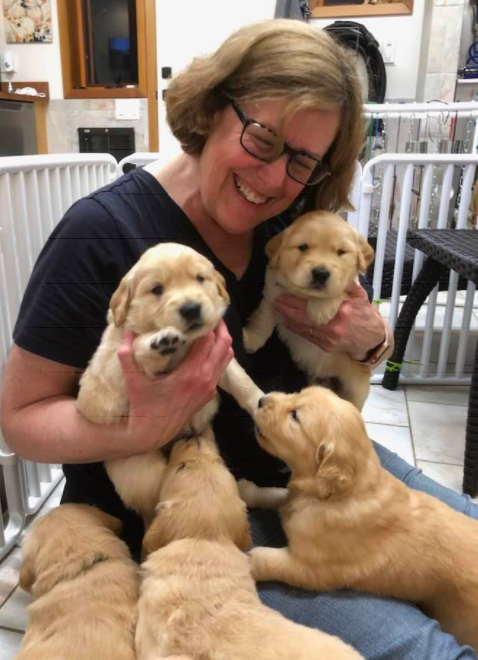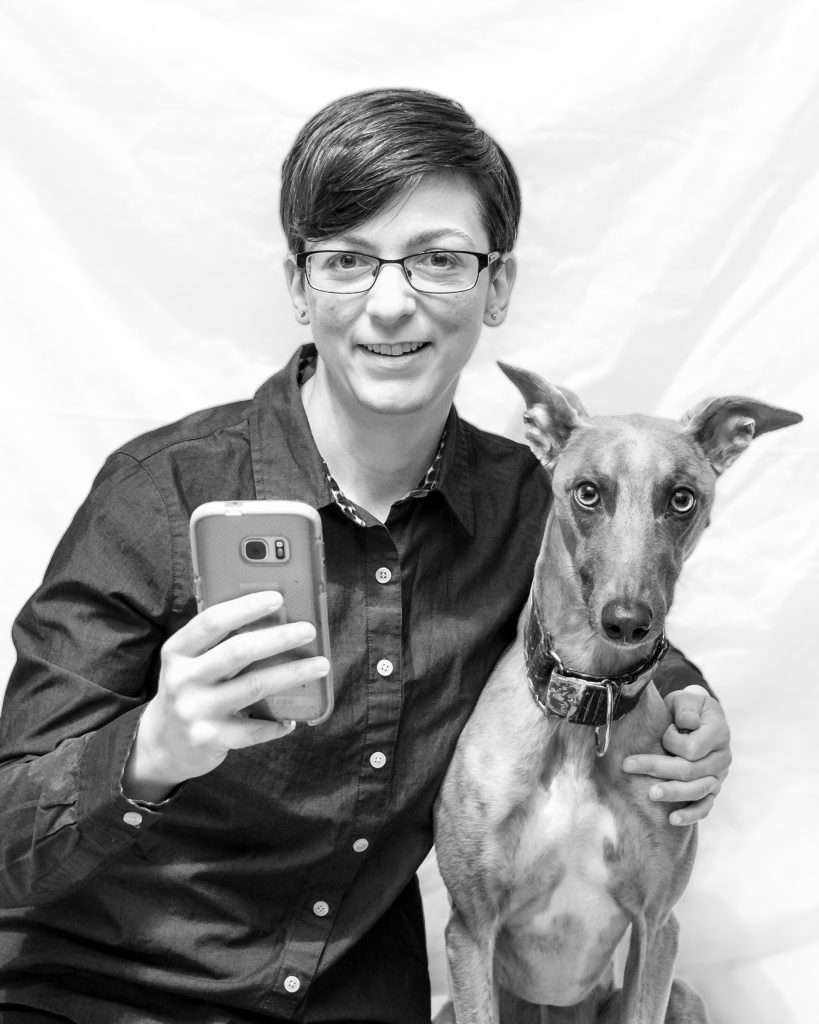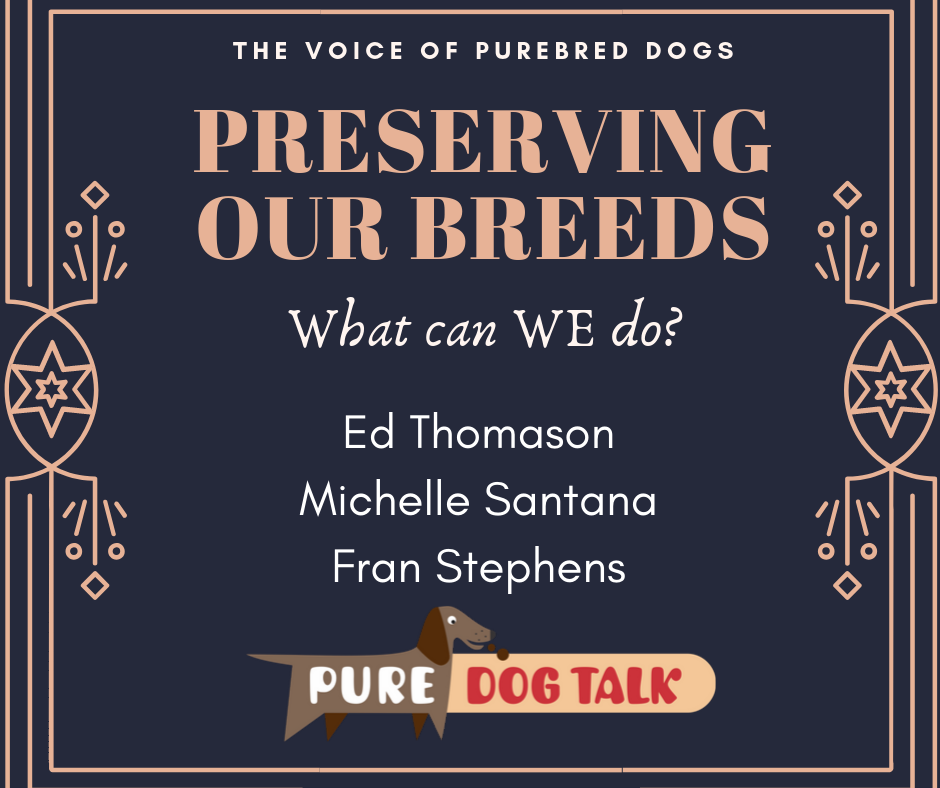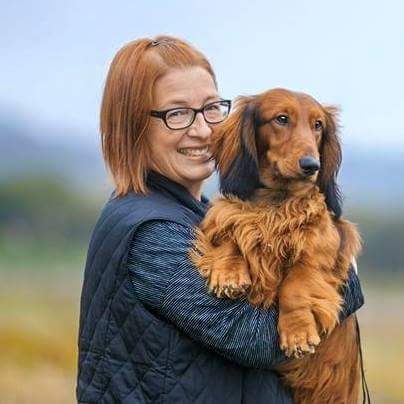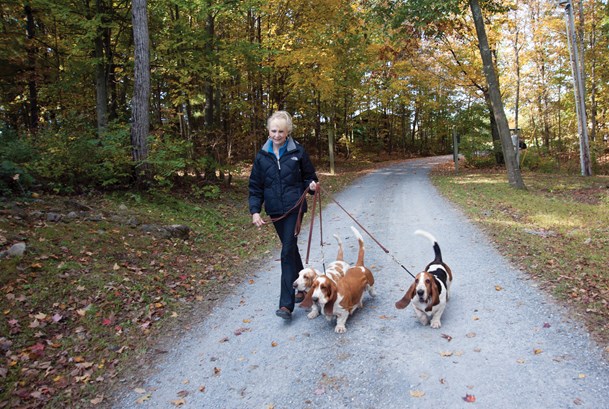393 – Gayle Watkins on Educating Breeders AND Buyers
Gayle Watkins on Educating Breeders AND Buyers
Dr. Gayle Watkins of Avidog and host Laura Reeves talk about the importance of educating both breeders and puppy buyers.
“We have to take step back,” Watkins said, “and realize how complicated our world is and how UNobvious it is, to even smart people that aren’t engaged with us, and help people understand and honestly for us to distinguish what really is important and what isn’t important…
“Let’s say you would like a 50- to 60-pound active sporting breed. You don’t care about color and what pops up (in an online search)? Both the German Wirehaired Pointer and the Golden Retriever, which is so wrong,” Watkins said. “So, finding a way to guide people in a more sophisticated way, in a way that you understand and I understand, the buyer doesn’t understand. They don’t know because they think of (dogs) as cars. They just come in different colors … but those of us who breed know that those cars are very, very different. There’s a whole big difference between a Maserati and a Volkswagen Beetle. (Even though they are the) same color and about the same size and they can only carry two passengers.”
In order to facilitate outreach and education of both ends of the dog purchase, breeders and buyers, Watkins has joined forces with Good Dog, a young company focused on educating the public and supporting dog breeders.
“We need people breeding dogs,” Watkins added. “So, if we have people who are interested in breeding dogs and doing it perhaps not to the level we would like to see, what’s better? Run them out or raise them up?
“We have to find a way to engage people more in producing quality pet dogs. The hobby breeders are going to continue in their sport and they’re going to continue to get championships and things like that, but we need more people who are trying to produce lovely pets…”
With an estimated 8-9 million replacement dogs needed just in the U.S. annually, as previous guests on Pure Dog Talk have noted, hobby breeders simply cannot meet the demand.
“How do we find those breeders, develop those breeders, lift those breeders up so we can keep playing the games that we love to play,” Watkins asks? “Because we’re not going to be able to, in my opinion, if we don’t change something. The laws, the legislatures, the government… the animal rights activists, they’re pretty successful now with adopt, don’t shop. We have got to find a way to fight them.
“I strongly believe we cannot fight animal rights if we divide each other. And boy we’re good at dividing. There’s got to be a bigger voice and I think that voice needs to be young, technologically sophisticated, and able to make enough money to fight for us. In the world that we live in, in purebred dogs, making money is anathema… and that has not gotten us to a very good place in defending our right to breed.
“I think what we did when we were attacked by the animal rights people is we said ‘oh we don’t make money doing this.’ That became our defense. That became our value. In doing that, it sets us up for failure on so many levels. It costs a lot of money to raise good puppies. If we don’t have the money to do our job well, now we’re opening ourselves up to attack from that perspective. (I think) we didn’t have the confidence or we didn’t have the backing or we didn’t have the organization to say ‘hey, you know, Mercedes makes a really nice car.’ It’s not that you can’t make money and do a great job. You can do both of those things. But if you make a puppy into a commodity, where one is the same as the other, right now you’re going to run into a problem. So, I think that value is one we have to overcome and then we have got to figure out a way to open our eyes to what’s changed in the world.”
Amongst the very first episodes on Pure Dog Talk were interviews with Watkins on puppy whelping and raising. These remain some of our most popular episodes.
Early Pure Dog Talk interviews with Gayle Watkins:
https://puredogtalk.com/11-dr-gayle-watkins-nutrition-dam-canine-nomographs/
https://puredogtalk.com/podcast/14-dr-gayle-watkins-2-breeders-guide-to-neonatal-puppies-2/
https://puredogtalk.com/14-friday-fun-dr-gayle-watkins-2-breeders-guide-neonatal-period-puppies/
https://puredogtalk.com/podcast/17-dr-gayle-watkins-transition-period-in-puppies-part-3-2/
https://puredogtalk.com/17-dr-gayle-watkins-transition-period-stimulation-puppies-part-3/
https://puredogtalk.com/podcast/20-bomb-proof-your-puppy-dr-gayle-watkins-4-2/
https://puredogtalk.com/20-gayle-watkins-bombproof-puppy-sensitive-period/
359 – “Space Whippet,” Insta Celeb, Provides Social Media Tips
“Space Whippet,” Insta Celeb, Provides Social Media Tips
Beth Gordon acquired a race-bred whippet after her mixed breed rescue developed IVDD (intervertebral disc disease). Kuiper the Space Whippet’s rise to fame on social media provides a blueprint for others to follow in promoting purebred dogs.
“I wanted a healthy dog I could do sports with. It’s ok to not want a project. We’ve spent as much as my college education on our older dog with health issues. I just didn’t want to have to do that again,” Gordon said.
“I decided we needed better influencers on this new-fangled thing called Instagram, Gordon said.” She wanted to do something that was informative, not just fluffy. A “space tree” in Salem, Oregon was the idea for the launch of Kuiper the Science Dog, Space Whippet.
In just a couple years, Gordon and Kuiper have acquired more than 150,000 Instagram followers and been to Kennedy Space Center for a photo shoot for the account.
Utterly shameless self-promotion makes all the difference, Gordon said. “Business cards cost $20 and people love to get them.”
“Even though the account name is space whippet, I get a lot of questions about his breed,” Gordon said. “I think it’s a good opportunity. The way you increase representation for anything is by showing it to people, not making a big deal out of it.
“When you’ve been fed this line there are so many rescue dogs, why don’t you have a rescue dog? My answer is that purebred dogs are not fungible with rescue dogs. If my choice was another rescue dog or no dog, I just wouldn’t get a dog. If you have specific things you want to do, you’re much better to get a breed designed for that.
“The general public doesn’t know there are so many things you can do with your dog. May not consider their dog trainable. Increasing awareness of the sports they can do is so important. Purebred dogs are not just for beauty, dogs are functional,” Gordon said.
326 – Preserving Our Breeds. What can WE do? Discussion pt. 1
Preserving Our Breeds. What can WE do?
Pure Dog Talk’s host Laura Reeves moderates a Saturday Symposium panel discussion at the Rogue Valley Kennel Club show on the topic of “Preserving Our Breeds. What can WE do?” This is part one of the discussion. Part two will post next week.
Panelists are Ed Thomason, professional handler and noted breeder of American Staffordshire Terriers; Michelle Santana, AKC Breeder of the Year of Doberman Pinschers; and, Fran Stephens, Saint Bernard breeder-judge and AKC delegate for Puyallup Valley Dog Fanciers.
The panelists discuss a recent presentation (watch the entire presentation here) to the delegate body by Bill Shelton and Doug Johnson among other areas of interest in which purebred dog fanciers can promote their breeds and purebred dogs in general.
“Tell our story”
“We have fallen into hiding the fact that we’re breeders,” Thomason said.
“Don’t be afraid to say I breed purebred dogs because I’m want to know what I’m going to get,” Stephens said.
“We have allowed doodle breeders to become a fad,” Thomason said. “You go underground because you have more dogs than you’re supposed to. But on social media, you can promote your breed, your breeding program without telling where you live.
The pet puppy market is a billion dollar industry. Not saying leave here and be puppy mills. Market being manipulated by doodle breeders and rescues. We don’t share our stories. We have to or this ain’t going to be here.”
Education is critical
Santana discussed her goal of educating John Q Public.
“I picked a random pet Doberman social page,” Santana said. “Thousands of people who own a companion Doberman. They need education. Any time I come across an educational article I share to that page. Spay/neuter as an example. Just pick one site that doesn’t get a broad spectrum of education and share to that page. We need to spread this information to people not in our circle. We’re myopic. We can talk to ourselves all we want. But we need to reach out to these people outside our circle.”
Stephens noted that there is a vast market for dogs in this country that is largely being filled by doodle breeders and rescue imports.
“There are plenty of people wanting dogs,” Stephens said. “It’s how we reach them. How we talk to them.”
Join us next week for Part 2 of the discussion!!
201 – Exhibitor Education Courses Come Online
“Crowdsourcing” Knowledge for Exhibitor Education
Vicki Ronchette, author of “From Shy to Showy,” has created a new exhibitor education resource with online college-type classes available on a wide variety of topics.
New owners, exhibitors who want to improve their performance and experienced members of the fancy who want to hone their skills will all find a topic of interest.
“A lot of people don’t have access to training classes near them,” Ronchette said. “Or the classes are more socialization and don’t offer a lot of information for training the dog or the handler.”
Listeners who missed Ronchette’s previous podcasts, can check out some of her outstanding positive training tips here and here.
Variety of courses available
Show Dog Prep School Courses include everything from training nail trims, to using Tellington TTouch for better results, to Safe Travel with dogs.
Full disclosure, your host, Laura Reeves, is an instructor for SDPS. Her first offering is: Canine Structure 101 and Applying the Breed Standard.
Courses are available with coaching from instructor, as well as a mentoring program with Ronchette, webinars, forums and more. The school is designed to offer easy navigation and a user-friendly platform.
Learn on YOUR schedule
“In today’s society, people don’t have a lot of time,” Ronchette said. “Show Dog Prep School allows people to learn on their own schedule. Virtual education is really helpful for folks to learn and get up to speed when they are just getting started.”
Ronchette is dedicated to the positive reinforcement system of dog training. And she applies it to her students.
“Positive reinforcement for people is so important,” Ronchette said. “We are creating a community of helping and support.”
People AND animals deserve to have an education so they can go in to a dog show with confidence and actually enjoy the sport and stay with it, Ronchette noted.
“We can help you understand the reason a dog didn’t win. It could actually be that your dog didn’t look as good. Let’s work on that,” Ronchette said.
Don’t miss Allison Foley’s Tip of the Week from the Leading Edge Dog Show Academy. Allison brings us *boggling* information about how to do up a coated breed beautifully – without power! Seriously, water and a bristle brush. What? Check it out.
168 – Breeder Education Advocate Claudia Orlandi Shares Knowledge
CLAUDIA ORLANDI ON EDUCATION AND DOG BREEDING
AN EARLY “EYE FOR A DOG”
Orlandi grew up with miniature and standard Poodles, but her first show dog was a Saint Bernard from Betty Roberts. When her family visited the breeder to pick a puppy, somehow the divider between the “show” dogs and the “pet” dogs had fallen down. With an “eye for a dog” at even an early age, the puppy her family chose led Orlandi into a life of dog shows. Eventually, shown by Bob Forsyth, that Saint Bernard became a Best in Show Winner.
“…structure and performance or, form following function, are the key characteristics of breed type and are what distinguish one breed from another.”
Horses and dogs were a passion she shared with her first husband, Dom. They acquired their first Basset Hound from a pack in Vermont. There they learned the functional aspect of their hound by following the pack on rabbit hunts. Orlandi now lives part-time in Spain, where she had just returned from a month of hunting with her hounds when we spoke for this interview.
“… I have to say that having had the experience of hunting with Emma (her first Basset) was a great starting point for really understanding the basset hound breed,” Orlandi said. “…structure and performance or, form following function, are the key characteristics of breed type and are what distinguish one breed from another.”
Orlandi attributes much of her knowledge of anatomy and animal husbandry to the 4-H program. In her shout out to the horse 4-H program she noted, “We had to pass difficult written and hands on tests on equine anatomy and movement, in addition to giving presentations and learning animal husbandry. All of this knowledge relating to horses, I was easily able to apply to breeding and showing dogs.”
But as she progressed in her breeding program, she came to understand that other breeders didn’t have the same good fortune.
“If we to learn about photography we can go to photography school,” Orlandi said. “If you want to become better cooks, we can take cooking classes. But at that time, we really didn’t have anything comparable if we wanted to learn to become better breeders.”
Knowledge is power, Orlandi noted, in everything that we do. So, she began to develop her education programs and books, including the fabulous Basset Hound University program she created and has shared with other Parent Clubs. She insists that breeders can be successful with some basic information to help them move forward.
Some of her best recommendations?
- …the concept of preservation breeding is an extremely important topic that deserves our ongoing support and attention.
- …one of the biggest myths is the belief that because breeding revolves around chance and randomness applying genetic principles won’t make a difference. Nothing could be farther from the truth. In reality, it’s very unlikely that a breeder can consistently produce healthy, quality dogs in which every generation the dogs are better than they were in the previous generations, without understanding how traits are passed from one generation to the next.
- …don’t purchase a bitch younger than 12 to 18 months. If you get a bitch much younger than this, they have not been able to do enough health tests and body structure might still be developing.
- …I think it’s really difficult, in a way, to find a good person to work with in a breeding program or to find a mentor. Because in a way it’s kind of like a marriage. I think you have to be psychologically compatible and you have to have a lot of the same goals and the same beliefs in common.
- … a few decades ago if people were honest about health problems they are absolutely shunned, many times, by their peers. Talking about health was considered taboo. Nowadays, we understand much more about controlling canine genetic disease and we know that if we’re honest about the health problems, about who the affected dogs are in our pedigrees we can control health problems in our breeding program very, very easily. But it all revolves around being honest.
Please enjoy my visit with this legendary advocate for breeder education in purebred dogs.

